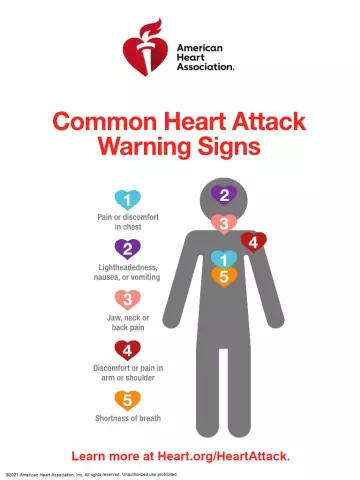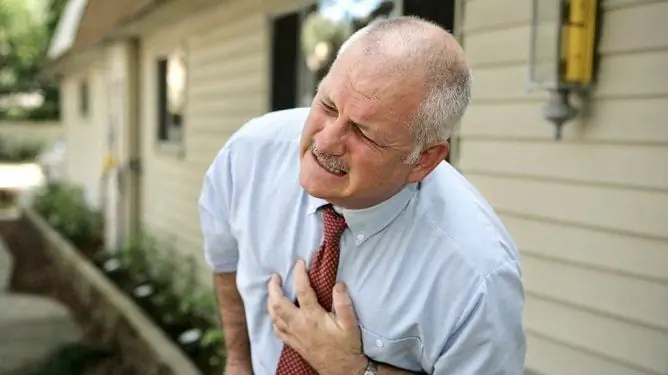- Author Rachel Wainwright [email protected].
- Public 2023-12-15 07:39.
- Last modified 2025-11-02 20:14.
Affective respiratory attack
The content of the article:
- Causes and risk factors
- Forms of the disease
- Symptoms
- Diagnostics
- Treatment
- Possible complications and consequences
- Forecast
- Prevention
Affective respiratory attack is a sudden short-term cessation of breathing in a child while crying. It develops against the background of an affective state and may be accompanied by loss of consciousness, in rare cases - convulsions. Occurs, according to various sources, in 5-13% of children.

Affective-respiratory attacks last up to 2-3 years (less often - up to 4-5)
Affect is a short-term, sudden emotional outburst, characterized by an explosive character and high intensity of manifestations.
Affective-respiratory manifestations are usually functional in nature: there are no structural disorders or abnormalities in the course of biochemical processes in the tissues of the central nervous and peripheral system in children prone to seizures.
For the first time the condition was described in 1737: “there is a disease in children arising from anger or sadness, when the soul is constrained and forcibly shifted from the heart to the diaphragm, causing a cessation or cessation of breathing, when the outburst of emotions ceases, the symptoms disappear”.
The condition, as a rule, manifests itself for the first time in the interval between 6 and 18 months of life and continues until the age of 2-3 years (less often - 4-5 years). In rare cases, the onset of affective-respiratory seizures occurs immediately after birth, or, even less often, at the age of over 3 years. The frequency of attacks is individual (from several per day to several per year), the maximum at the age of 1 to 2 years.
Synonyms: affective-respiratory seizures, rolling in crying, breath-holding attacks, apnea attacks.
Causes and risk factors
There is no consensus on the causes of this condition, although the main theory is the psychogenic onset of affective-respiratory seizures.
There is a point of view that seizures are usually observed in emotionally mobile, irritable, prone to whims of children and are some semblance of hysterical seizures. In response to painful or negative psychoemotional effects, the child develops corresponding symptoms.
Some authors note the importance of the problem of interpersonal intrafamily relationships or phenomena of overprotection. Studies conducted in 2008 showed that children who are prone to affective-respiratory attacks have higher levels of emotionality, activity, intensity of emotions and distraction.
Despite the obvious influence of the psychological component, most experts still believe that this phenomenon occurs not only in emotionally difficult children; the following factors play an important role:
- hereditary predisposition (25-30% of children have a burdened heredity for affective-respiratory seizures, when at least one of the parents suffered from them;
- cardiovascular pathology;
- iron deficiency, which is necessary for the metabolism of catecholamines and adequate transmission of nerve impulses;
- the epileptic nature of the condition.
Emotional factors that can trigger an attack:
- irritation;
- discontent;
- feeling of dissatisfaction;
- fear, fear.
Seizures develop more often if the child is overworked or overexcited, hungry, or in an unfamiliar environment.
Forms of the disease
The following forms of seizures are distinguished:
- with cyanosis ("blue" form);
- with pallor ("pale" form);
- mixed.
The pathophysiology of a "blue" attack is caused by a sudden spasm of the muscles of the larynx and respiratory muscles, which leads to an increase in pressure in the chest cavity, which provokes a decrease in cardiac output and a decrease in cerebral blood flow with the development of acute transient oxygen starvation. In the role of a trigger, an imbalance in the links of the autonomic nervous system is assumed.
In the development of a "pale" attack, the leading role belongs to excessive parasympathetic impulses, when, under the influence of the inhibitory effects of the vagus nerve, the child's heart rate decreases or asystole develops (instantaneous - no more than 1-2 seconds - cessation of heart activity), which causes an attack. Short asystole occurs in 61-78% of children with a "pale" form of affective-respiratory seizures.

Short-term asystole precedes a "pale" affective-respiratory attack in 61-78% of cases
Symptoms
The episode of the "blue" affective-respiratory seizure usually begins with uncontrollable crying for several seconds (no more than 10-15), after which there is a sudden stop of breathing on exhalation, which is characterized by the following symptoms:
- mouth is open, inhalation does not occur;
- crying stops;
- cyanosis is rapidly increasing;
- for several seconds (up to several minutes, as a rule, no more than 0.5-1 minutes), there is no breathing (apnea develops).
If apnea lasts more than 1 minute, loss of consciousness, “limpness”, alternating with muscle tension of the trunk, stretching or bending it is possible. If oxygen access is not restored, the phase of clonic seizures begins (twitching of the child's limbs and trunk).
Prolonged holding of breath and, as a consequence, the supply of oxygen provokes hypercapnia (excess accumulation of carbon dioxide in the blood), which causes a reflex release of the spasm of the muscles of the larynx: the child inhales and begins to breathe, regains consciousness.
After such a prolonged attack of tonic or clonic seizures, deep sleep usually occurs for 1 to 2 hours.
While holding their breath may seem deliberate, children don't do it on purpose; a reflex occurs when a crying baby exhales air from the lungs with force while crying.
"Pale" attacks are more often provoked by fear, sudden pain stimulus (injection, hitting the head, falling, etc.) or a combination of these factors. The child can cry, but more often it simply calms down, loses consciousness and turns pale. Weakness and pouring sweat are characteristic, the pulse cannot be felt for several seconds. In the most severe episodes, clonic contractions of the limb muscles and involuntary urination are possible.
Diagnostics
Diagnosis of affective-respiratory seizures does not cause difficulties if the connection with the previous traumatic effect is confirmed and there are similar episodes of respiratory arrest in the anamnesis.

To clarify the diagnosis of "affective-respiratory attack" helps to conduct an ECG
Additional studies are sometimes recommended to clarify the diagnosis:
- ECG (asystole episodes are recorded);
- EEG (a slowdown or decrease in the amplitude of the impulses is detected).
Treatment
There is no need for special drug treatment for affective-respiratory seizures. There are several reasons for this:
- in the overwhelming majority of cases, affective-respiratory seizures stop on their own when the child reaches a certain age or when the environment changes (kindergarten, preparatory courses in primary school, etc.);
- at the moment, there are no drugs that have proven efficacy in preventing seizures;
- this condition is not pathological.
There are several ways that help interrupt the attack and reflexively restore breathing: blow sharply on the child, splash water on the face, and gently pat on the cheek.

Parents may try to distract the child in order to interrupt an affective-respiratory seizure.
Non-specific treatment aimed at improving metabolism in brain tissues, normalizing the balance of excitation and inhibition processes is as follows:
- nootropic drugs;
- vegetable sedatives;
- neurotropic vitamins (group B);
- physiotherapy procedures.
Possible complications and consequences
Affective-respiratory seizures, as a rule, do not have negative consequences, are short-term, do not worsen the child's health and are not able to affect the functioning of organs and systems in the future.
A prolonged attack with prolonged respiratory arrest for several minutes in the presence of severe concomitant pathologies can lead to cessation of cardiac activity, coma.
The literature describes only a few deaths that were due to aspiration.
Forecast
Favorable.
Prevention
The main preventive direction is psychotherapeutic influence (the formation and maintenance of a child's productive position in relation to the environment, an adequate perception of his place in the family hierarchy and the correct reactions to certain external influences).
Psychological techniques that will prevent the development of seizures are as follows:
- to prevent situations of long waiting or being on the road, rushing when the child is hungry, wants to sleep or experiences a feeling of physical discomfort (taking into account that the provocateurs of affective-respiratory seizures are hunger, overwork, feeling of irritation);
- talk traumatic situations with the child, provide him with the opportunity to express desires;
- clearly define in advance the rules of conduct adopted in a particular place;
- switch the child's attention from negative emotions to positive impressions.
YouTube video related to the article:

Olesya Smolnyakova Therapy, clinical pharmacology and pharmacotherapy About the author
Education: higher, 2004 (GOU VPO "Kursk State Medical University"), specialty "General Medicine", qualification "Doctor". 2008-2012 - Postgraduate student of the Department of Clinical Pharmacology, KSMU, Candidate of Medical Sciences (2013, specialty "Pharmacology, Clinical Pharmacology"). 2014-2015 - professional retraining, specialty "Management in education", FSBEI HPE "KSU".
The information is generalized and provided for informational purposes only. At the first sign of illness, see your doctor. Self-medication is hazardous to health!






